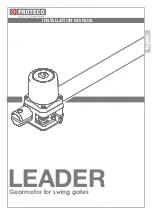
3
DS902010-001B
Abb. / Fig. 4
Abb. / Fig. 5
Abb. / Fig. 6
Thank you for having chosen a quality product of Bitron Home, an Urmet Group brand. Bitron Home
products have been specifically designed for use with the QIVICON platform for which they are approved.
QIVICON enables you to manage and control you smart phone in a really easy way: applications for PC,
tablet and smartphone let you manage all connected devise, at any time and from anywhere.
MOUNTING
You can install the magnetic contact and the magnet either by screws or using adhesive strips. In order to
ensure a reliable and safe operation we suggest a fixed mounting of the magnetic contact. Screws, dowels
and double-sided adhesive tape are included in the packaging of the product. If required you may use the
spacers included to adjust the magnet’s position.
Please make sure that the distance between the magnet and the ribbed side-surface of the magnetic
contact does not exceed 25 mm in closed state.
SET-UP AND OPERATION
This step requires that you have a QIVICON Home Base equipped with a QIVICON ZigBee radio dongle.
1. Remove plastic cover, which protects the battery during transport on the back of the device (
Fig. 1
).
2. Follow the indications for the addition of new devices of the installation wizard, which can be found in
the app or in the web interface of your QIVICON system. For further information on the registration
process, please consult http://support.bitronhome.eu.
If you wish to associate the device to a different home base, it is sufficient to repeat the procedure of your
system for the addition of new devices. Once successfully concluded the installation process, the sensor
will not communicate with the system, to which it has been previously registered, anymore.
You can use the magnetic contact in order to connect external alarm contacts. Such contacts could be
wired door and window contacts or any other sensor, which signals its status through normally closed
contact. In order to connect the external contact, open the magnetic contact by removing the screw (
Fig.
6/H
) and connect the cable to the terminal connector (
Fig. 5/D
). If jumper JP3 (
Fig. 5/E
) is closed, only the
status of the external contact will be transmitted. If JP3 is open, also the status of the internal contact will
be considered (
Fig. 4
). After changing the jumper configuration, a restart of the sensor is required (unplug
and re-insert battery).
In order to replace the battery, open the magnetic contact (
Fig. 6/H
) and replace the battery (
Fig. 5/F
) by a
model of identic type (Lithium CR2 3V). It is not necessary to register the contact again.






















